7/12 - Japanese territorial waters
I'm all packed except for a few cabin utensils and maybe the Scotch if I can't convince the Russians to take it. If they don't, some Japanese hobo is going to have the best day of his street life, because I don't need it any more and really need to drop pack weight/volume in order to do the tourism I have planned and bring omiyage back. A lot of what was useful in Russia is no longer so, and when something's use is out, it needs to be ditched ASAP. I need to create a lot of space in the main pack to go back airmobile with two boxes of momiji manju in there, so the cull made this morning is just the start.
I also changed the camera battery out; it wasn't dead per se, but it had been dropping to one bar pretty frequently, and I didn't want to have to scramble for a quick-change somewhere on the train or in the Peace Park. I can charge up in the hotel without interfering with anything else, because the sockets in Japan, finally, won't require my trusty plug adapter.

0761. First sight of land; the northern spur that protects Sakaiminato harbor.

0762. A freighter ahead in our track.

0763. Sky and sea.

0764. Broadside on that freighter.
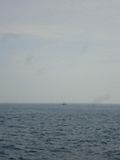
0765. Rock and lighthouse astern.

0766. Rounding the spur.

0767. Exposed rocks at the tip.

0768. On to the north side of the harbor.

0769. John's friend from bunk 5 clowning around.

0770. South to the Tottori coast.

0771. Our bow cuts the waves into regular lines of foam.
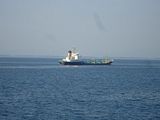
0772. Fishing boat, sitting at anchor.

0773. Coast Guard cutter on station.

0774. Closer to the coast.

0775. Broadside on the cutter.

0776. Freighter in drydock.

0777. Town and bridge ahead.

0778. Buoy and breakwater.

0779. Ahead to the bridge, since we're not gonna go under it.

0780. Breakwater and seawall.

0781. Passing the lighthouse.

0782. Headland of the port.

0783. Heron at the foot of the seawall.

0784. Across land and waters into town.

0785. Kaikoumaru 36-go at anchor; I saw #23 tied up a little further on while hiking into town, so not all of #1 through #35 are on the bottom of the ocean.

0786. Tug steaming past.

0787. Unusual power plant or something amidships.
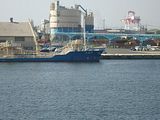
0788. Kanji on the bow; not read onsite.

0789. South foot of the bridge as we started to turn.

0790. Mountains on the north shore.

0791. Forest and narrow road below.

0792. Turning to expose the north shore.

0793. Small bridge over an inlet.

0794. Water, forested mountains, sky.

0795. Weather radome north above the town.
An American traveling alone from Russia to South Korea to Japan with an immense army pack and a thick beard invites questions; despite a professional but very thorough search by Japanese customs, I didn't have to surrender anything else, and despite a longer than expected hike along the waterfront, I didn't get killed by a truck on the narrower Japanese roads. Also, despite that longer hike and a lot of time in Mizuki Road -- three caps and a gatchapon getto -- I made the 10:30 connection out of Sakaiminato. Hopefully, I can get the morning written up in the 45 minutes to Yonago.

0796. There's something about the smell of an open drainage ditch in summer that's uniquely Japanese.

0797. Taka ga ippai -- probably kestrels watching out for spare fish guts.

0798. Bridge span from the road.

0799. Everything, including Chugoku -- 'Central', here, not 'China' -- Electric Power, has its mascot chara.

0800. Ads for Mizuki Road attractions.

0801. Bridge over rural foliage.

0802. Along the wharf road.

0803. Character memorial stone.

0804. Cafe Popeye.

0805. Signs pointing to turn-ins.

0806. On Mizuki Road; both sides are lined with these characters from Gegege no Kitaro.

0807. Sakeya with Medamaoyaji on the sign. On the way back, I picked up a local microbrew with a comic-themed painted bottle, as seen later on.

0808. All mouth.

0809. Kitaro plate in the sidewalk.

0810. Salaryman Yamada, freaking out at all the youkai around him.

0811. Big statue of Nezumiotoko.

0812. My Dad the Eyeball.

0813. Kitaro, wearing a certain battered army hat that by this time, had in one way or another been entirely around the world.
video20: Rotating eyeball fountain.

0814. Park closer to the station. Note the lamps.

0815. Kitaro and Medamaoyaji.

0816. Characters over the Tottori map.

0817. Focus on the totem pole.

0818. Big panel on the station building.

0819. Sensei at his desk.

0820. The Nezumiotoko train, outbound to Yonago.
Barely done, with ten minutes to spare. The pen is also almost done, but should have enough in it to reach Hiroshima.
- Yonago -
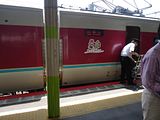
0821. More charas on the limited express. This trip will use all three classes of JR in regular service: the local train got me to Yonago, and this normal intercity express takes me to a connection with the Shinkansen.
video21: Arakawa past the bridge, at great speed.
I likely won't be able to take many pictures from the train, despite the two-hour journey; part of this is the speed (which was not really an issue in Russia), and part of it is that this train has to cross the Japan Alps, which means tunnels.

0822. Misty mountain ahead.

0823. Better-defined peaks behind.

0824. Fields and orchards.

0825. Ahead; mountain and village.

0826. Mountains, houses, and either Medamaoyaji or that guy from Siberia again.

0827. Three rounded domes.

0828. Smoke across fields.

0829. Inside the cabin. This is a midday train on a Friday going cross-country -- most of the main cities in both the Kanto and Kansai plains are on the south side of the mountains -- so there's next to nobody in the car.

0830. Viaduct between peaks.

0831. River valley just before a tunnel.

0832. Ahead to a range of valleys.

0833. Valley and river.

0834. Wide mountains bored through.

0835. High peaks and that youkai.

0836. Peak and forest.

0837. Mountain pass over station parking lot, Neu.
Going through these mountain villages and seeing tombstones by the fields and in people's very dooryards, it's easy to see how a guy from the rural north coast could and would work up a world of spirits and phantoms. Here, the dead are not off in some park miles away -- no, the ancestors remain where they lived and died, in the same house or at least around the corner.

0838. River and mountain pass.

0839. Ahead on the river.

0840. Mountain, rounding a bend in the river.
My stomach's growling bad, and I've only got like 5 minutes between trains in Okayama. Good thing I still have that last chunk of bread left over from Russia.

0841. Fields and mountain pass.

0842. Great view with artifacts. Try to avoid, take what you can get.

0843. Back to a grove of bamboo -- it's the green puffy stuff.

0844. A river lines up.

0845. River, road, and mountains outside Shouyama.

0846. Shouyama village and mountains.

0847. High peak rising over others.

0848. Terraced fields through the reflections.

0849. This is a route-marked highway. Japanese mountain roads are not for the faint of heart.

0850. Back to a bamboo grove by the roadside.

0851. River bottom with artifacts.
video22: Truck on route 8. This isn't a one-way road! It's just got only one lane to it, for both directions to share. Again, this is a numbered national highway.

0852. More of route 8.

0853. River, fields, and viaducts.

0854. Ahead on a mountain stream.

0855. Back at the mountains passed through, outside -- I would not make this up -- Bit'chuu-Kojiro. Sorry, going back to Japan has apparently made me go back to being nine years old.

0856. River below the mountains.

0857. Flooded rice paddy behind.

0858. Mountains and city, coming in to Niimi.

0859. Scoured landscape behind a bridge.

0860. Another scoured mountain.

0861. Both sides cracked.

0862. Same mountain, more sky.

0863. Terraces cut by quarrying.

0864. Quarried and scoured mountains.

0865. More sheer slopes ahead.
There's about two more incredible views I don't get for every picture that makes it into this record. As in Siberia, I can only recommend taking this trip yourself -- and as a bonus, it's shorter and involves no "schnitzel" of indeterminate origin.

0866. River in flood.

0867. Into mountain fastnesses.

0868. Ahead over rapids.

0869. Bridge and mountains upriver.

0870. Terraced fields and old-style house, Bit'chuu-Kawamo. Sorry, still 9.
It's a good thing I brought Summer Wars, because after all this rural scenery, I really want to watch it again.

0871. Riverbank and shorings.

0872. Wide river in bright sun.

0873. Sky above the mountains.

0874. Ki no nai yama, Kinoyama. HURR PUN HURR. Going native already.
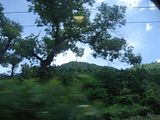
0875. Mountaintop through a gnarled tree.

0876. Impression/accident: clouds and traditional roofs, Bitchuu-Takahashi.

0877. City, mountains, and sky, Bitchuu-Takahashi.

0878. See, I'm not making these place names up.
Further clarification: these places are all in Bitchuu Province, but because there are a lot of places in Japan called Kawamo, Kojiro, or Takahashi, they need to be further specified in order to become a unique JR station code. You can see this in a couple stops on the Trans-Sib as well; Chernishevsk-Zabaikal'sk, for example, means "the Chernishevsk in Zabaikalskiy Krai, and not any other Chernishevsk served by RZD that might have name precedence". Also, you can see from the kanji on the sign that the pronunciation is really more in the line of "bit'chuu" rather than a lulzy false cognate; you'll want "bich'chi", in katakana, if you want to call someone a bitch in Japanese like a Tokyo teenager. (Chanbara fans and wannabe yakuza will still use 糞尼 like normal, preferably in heavy brush calligraphy if possible.)

0879. Mountain slope and field, leaving town.

0880. Great mountain color.

0881. Into the scar.

0882. Valley behind, including a bit of a flood dam.

0883. Western building in the middle of the mountain.

0884. Village in a valley.

0885. Urban agriculture; a working rice paddy in Kurashiki.
- Okayama -

0886. Okayama shinkansen tracks. Definite German -- ok, Berlin Hbf -- feel to it.
Sightseeing from the shinkansen is an exercise in stupidity. So is expecting to get a seat in a non-reserved car in the middle of the day Friday. :[.
- Hiroshima -

0887. Billy the Kid karaoke bar, Hiroshima.

0888. The boss of all of them.

0889. Your friend and mine, Yukichi-san.

0890. The get of all cap gets, at least from this trip. The bottle is coming home as well.
Japan is awesome, but deadly hot and sticky, especially in full pack. October is probably very nice, but in October you're already getting snow in Irkutsk, making this particular trip a little iffy.
The plan is to rest a little, get an unagi-don outside the station, then take the #6 line to the Peace Dome and look around there as an adult, then hare back, load up on caps wherever possible, maybe hit up an ATM, and then drink, relax, watch Summer Wars, taunt friends on the internet, and finalize plans for tomorrow.

0891. My room looks out onto the wedding garden/putting green. A great reason to keep the curtains drawn -- but then again, "giant hairy naked gaijin scratching himself" is just about the best reason for a wedding to be ruined ever.

0892. 日本のアニメ!!!1!
OH FUCK it's sumo season. I forgot. Well, there goes any thought of doing anything else. Dammit.

0893. No 13, but cleverly disguised.

0894. Campaign truck ready to roll.
- Peace Park -

0895. The fire of one sun -- can you imagine a thousand?

0896. Memorial stone by the river.

0897. Genbaku-dome, under rework. The skeleton of the hall survived because it was a reinforced concrete building almost directly under (not quite, we'll get to the hypocenter in a second) the detonating bomb. The force of the blast was almost directly down (lateral shockwaves are a lot worse for tall structures, especially driving debris), and there was less air between the detonation and the building to get turned into a shockwave. The building survived the immediate blast, but this does not change the fact that it's a nearly-hundred-year-old structure that got attacked with a nuclear weapon seventy years ago. It will fall down and stop being an effective memorial if it's not worked on from time to time.

0898. A look down to the river below.

0899. Needing no reconstruction -- only one source of heat can deform cast concrete like this.
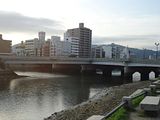
0900. The original AP.

0901. Memorial tower south of the dome.

0902. Look up -- the fire is already falling upon you. At the hypocenter.

0903. Hypocenter memorial plaque.

0904. This priest guards a cemetery near the park. The purpose is unmistakable, the graves unphotographed.

0905. A long look up the river.

0906. And above, into the far mountains.

0907. Eternal flame and memorial.

0908. Children's peace memorial.

0909. Waves in the topiary.

0910. Memorial mound, west side of the park.

0911. Cenotaph amid the trees.

0912. Peace bell.

0913. Dome reflected in the river at sunset.
In early August 1945, my paternal grandfather was a corpsman on a destroyer operating in the Pacific theater. He had survived several kamikaze attacks, including one that he somehow managed to sleep through entirely. The date was unknown, but everyone in the fleet knew that with Okinawa conquered, the next step was an invasion of Kyushu, sometime in the fall of 1945. The Japanese had resisted to the death on Iwo Jima and Okinawa, and the expectation was that they would defend the home islands even more vigorously. With initial estimates of 1 million Japanese deaths (military and civilian) on Kyushu, and 500,000 American casualties before the island was taken/pacified enough to be used as a springboard into southwestern Honshu, it is likely but not certain that other kamikaze attacks would have come, and my grandfather would have left the theater in a rubberized bag to be mated up with a pine box.
But there was no invasion of Kyushu. Instead of a million to a million and a half dead across both sides, about 200,000 Japanese died either in the immediate blasts or from fallout and radiation poisoning in the weeks, months, years, and decades after, because the United States unilaterally decided that the horrors of nuclear war were not worse than the horrors that would follow without it. It was the right decision for me, a literal child of the bomb, and thousands if not millions like me, Japanese as well as American, who would never have lived if our ancestors had died in a useless and suicidal conventional fight to reach the same conclusion. But it was the wrong decision for literally everyone else: the thousands of civilians instantly incinerated out of a wide blue sky, and the tens of thousands more who died in horrible pain at the rivers boiled and ash fell that killed flesh before the heart stopped, and also everyone else in the world, then, since, now, and forever, who live under the sword of Damocles that Truman forged. "The Allies" did not bomb Hiroshima. The President of the United States, with sole authority over his nation's nuclear weapons, made the unilateral decision that it was less bad to use them than not to. Right now, there are eight heads of state with the ability to make that decision. Tomorrow, there may be nine or ten. The day after, not all of them may necessarily be heads of state. The fission reaction, at criticality, does not care.
I lived in Dresden, and here as there, the memorials of atrocity are also a lived space for the population; you can't keep in mourning forever. But there's something different here as well, a sense that something different was at play. Since there have been cities, armies have sacked cities, burned them, and slaughtered innocents by the hecatomb. The difference here, as at Auschwitz -- physics here, business administration there -- is the realization that science has provided us a weapon too sharp for mortals to wield, whereby the killing capacity multiplies and multiplies to and past the point at which it can be effectively controlled. The nuclear weapons community tries to pretend past this with dial-a-yield and increased precision allowing smaller warheads, but this is ultimately bunk: your choice is between a holocaust or an even more unacceptably large holocaust. What we need instead, as every scientist with an ounce of humanity who worked on the bombs came to realize, is a new way of thinking, a new way of human conduct, whereby we never get to a place where it is not worse to use nuclear arms than to not use them. Are we there yet? No reaction has flashed in anger since 1945, which is a good start, but there remain thousands, millions, maybe billions not yet convinced. All the time we have is until one or more of them find themselves in Truman's chair.

0914. Helical twists in the Seiko clock tower. Hope, or another warning?

0915. Dark clouds over the peace dome.

0916. Back at the station, a pachinko parlor lights up the night.

0917. Back streets of Hiroshima at night.
The problem with Japan at this time of year is that it only starts getting livable at like 8pm. This is fine -- places stay open till 3 -- if you have stuff to do during the day, preferably inside, but it's a little hard for someone with two days only and a need for daylight.

0918. Kankohi LIKE A BAWS. This is truly the boss of all can coffees; as the name implies, it's dead black, without milk or sugar, exactly how I make my own.

0919. Even Japan has crappy Flash shows, too.
Watching Giants-Dragons with some Sapporo. Family Mart only has cans, so I need to find an actual sakeya to get bottles and from them, caps. The beer garden is maybe late, maybe tomorrow; I kinda want to refuel my wallet first, because me + massbier ends with a large bill and many empty vessels.
It's not to be a bad omen, watching Pom Poko before I go to find an old house in a rural area that's seen a lot of development, but it's on broadcast TV, what am I supposed to do?
As I was falling asleep, I realized that while the pillow was ok, the cover wasn't as hypoallergenic. Simple resolution; I turned off the AC, then unlashed my jacket from my pack to use as a blanket and slept, in a luxury hotel in the middle of Hiroshima, like I was in a bus station in the mountains.
No comments:
Post a Comment